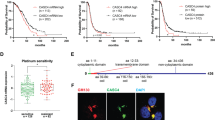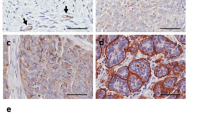Abstract
Hematogenous metastases are rarely present at diagnosis of ovarian clear cell carcinoma (OCC). Instead dissemination of these tumors is characteristically via direct extension of the primary tumor into nearby organs and the spread of exfoliated tumor cells throughout the peritoneum, initially via the peritoneal fluid, and later via ascites that accumulates as a result of disruption of the lymphatic system. The molecular mechanisms orchestrating these processes are uncertain. In particular, the signaling pathways used by malignant cells to survive the stresses of anchorage-free growth in peritoneal fluid and ascites, and to colonize remote sites, are poorly defined. We demonstrate that the transmembrane glycoprotein CUB-domain-containing protein 1 (CDCP1) has important and inhibitable roles in these processes. In vitro assays indicate that CDCP1 mediates formation and survival of OCC spheroids, as well as cell migration and chemoresistance. Disruption of CDCP1 via silencing and antibody-mediated inhibition markedly reduce the ability of TOV21G OCC cells to form intraperitoneal tumors and induce accumulation of ascites in mice. Mechanistically our data suggest that CDCP1 effects are mediated via a novel mechanism of protein kinase B (Akt) activation. Immunohistochemical analysis also suggested that CDCP1 is functionally important in OCC, with its expression elevated in 90% of 198 OCC tumors and increased CDCP1 expression correlating with poor patient disease-free and overall survival. This analysis also showed that CDCP1 is largely restricted to the surface of malignant cells where it is accessible to therapeutic antibodies. Importantly, antibody-mediated blockade of CDCP1 in vivo significantly increased the anti-tumor efficacy of carboplatin, the chemotherapy most commonly used to treat OCC. In summary, our data indicate that CDCP1 is important in the progression of OCC and that targeting pathways mediated by this protein may be useful for the management of OCC, potentially in combination with chemotherapies and agents targeting the Akt pathway.
This is a preview of subscription content, access via your institution
Access options
Subscribe to this journal
Receive 50 print issues and online access
$259.00 per year
only $5.18 per issue
Buy this article
- Purchase on Springer Link
- Instant access to full article PDF
Prices may be subject to local taxes which are calculated during checkout






Similar content being viewed by others
References
Jemal A, Bray F, Center MM, Ferlay J, Ward E, Forman D . Global cancer statistics. CA Cancer J Clin 2011; 61: 69–90.
Tan DS, Miller RE, Kaye SB . New perspectives on molecular targeted therapy in ovarian clear cell carcinoma. Br J Cancer 2013; 108: 1553–1559.
Chan JK, Teoh D, Hu JM, Shin JY, Osann K, Kapp DS . Do clear cell ovarian carcinomas have poorer prognosis compared to other epithelial cell types? A study of 1411 clear cell ovarian cancers. Gynecol Oncol 2008; 109: 370–376.
Sugiyama T, Kamura T, Kigawa J, Terakawa N, Kikuchi Y, Kita T et al. Clinical characteristics of clear cell carcinoma of the ovary: a distinct histologic type with poor prognosis and resistance to platinum-based chemotherapy. Cancer 2000; 88: 2584–2589.
Al-Barrak J, Santos JL, Tinker A, Hoskins P, Gilks CB, Lau H et al. Exploring palliative treatment outcomes in women with advanced or recurrent ovarian clear cell carcinoma. Gynecol Oncol 2011; 122: 107–110.
Hoskins PJ, Le N, Gilks B, Tinker A, Santos J, Wong F et al. Low-stage ovarian clear cell carcinoma: population-based outcomes in British Columbia, Canada, with evidence for a survival benefit as a result of irradiation. J Clin Oncol 2012; 30: 1656–1662.
Lengyel E . Ovarian cancer development and metastasis. Am J Pathol 2010; 177: 1053–1064.
Tan DS, Agarwal R, Kaye SB . Mechanisms of transcoelomic metastasis in ovarian cancer. Lancet Oncol 2006; 7: 925–934.
Wortmann A, He Y, Deryugina EI, Quigley JP, Hooper JD . The cell surface glycoprotein CDCP1 in cancer—insights, opportunities, and challenges. IUBMB Life 2009; 61: 723–730.
Spassov DS, Wong CH, Wong SY, Reiter JF, Moasser MM . Trask loss enhances tumorigenic growth by liberating integrin signaling and growth factor receptor cross-talk in unanchored cells. Cancer Res 2013; 73: 1168–1179.
Tang T, Li L, Tang J, Li Y, Lin WY, Martin F et al. A mouse knockout library for secreted and transmembrane proteins. Nat Biotechnol 2010; 28: 749–755.
Awakura Y, Nakamura E, Takahashi T, Kotani H, Mikami Y, Kadowaki T et al. Microarray-based identification of CUB-domain containing protein 1 as a potential prognostic marker in conventional renal cell carcinoma. J Cancer Res Clin Oncol 2008; 134: 1363–1369.
Emerling BM, Benes CH, Poulogiannis G, Bell EL, Courtney K, Liu H et al. Identification of CDCP1 as a hypoxia-inducible factor 2α (HIF-2α) target gene that is associated with survival in clear cell renal cell carcinoma patients. Proc Natl Acad Sci USA 2013; 110: 3483–3488.
Gao W, Chen L, Ma Z, Du Z, Zhao Z, Hu Z et al. Isolation and phenotypic characterization of colorectal cancer stem cells with organ-specific metastatic potential. Gastroenterology 2013; 145: 636–46 e5.
Ikeda J, Oda T, Inoue M, Uekita T, Sakai R, Okumura M et al. Expression of CUB domain containing protein (CDCP1) is correlated with prognosis and survival of patients with adenocarcinoma of lung. Cancer Sci 2009; 100: 429–433.
Miyazawa Y, Uekita T, Hiraoka N, Fujii S, Kosuge T, Kanai Y et al. CUB domain-containing protein 1, a prognostic factor for human pancreatic cancers, promotes cell migration and extracellular matrix degradation. Cancer Res 2010; 70: 5136–5146.
Razorenova OV, Finger EC, Colavitti R, Chernikova SB, Boiko AD, Chan CK et al. VHL loss in renal cell carcinoma leads to up-regulation of CUB domain-containing protein 1 to stimulate PKCδ-driven migration. Proc Natl Acad Sci USA 2011; 108: 1931–1936.
Casar B, He Y, Iconomou M, Hooper JD, Quigley JP, Deryugina EI . Blocking of CDCP1 cleavage in vivo prevents Akt-dependent survival and inhibits metastatic colonization through PARP1-mediated apoptosis of cancer cells. Oncogene 2012; 31: 3924–3938.
Deryugina EI, Conn EM, Wortmann A, Partridge JJ, Kupriyanova TA, Ardi VC et al. Functional role of cell surface CUB domain-containing protein 1 in tumor cell dissemination. Mol Cancer Res 2009; 7: 1197–1211.
Casar B, Rimann I, Kato H, Shattil SJ, Quigley JP, Deryugina EI . In vivo cleaved CDCP1 promotes early tumor dissemination via complexing with activated beta1 integrin and induction of FAK/PI3K/Akt motility signaling. Oncogene 2014; 33: 255–268.
Liu H, Ong SE, Badu-Nkansah K, Schindler J, White FM, Hynes RO . CUB-domain-containing protein 1 (CDCP1) activates Src to promote melanoma metastasis. Proc Natl Acad Sci USA 2011; 108: 1379–1384.
Huang RY, Chung VY, Thiery JP . Targeting pathways contributing to epithelial-mesenchymal transition (EMT) in epithelial ovarian cancer. Curr Drug Targets 2012; 13: 1649–1653.
Dong Y, He Y, de Boer L, Stack MS, Lumley JW, Clements JA et al. The cell surface glycoprotein CUB domain-containing protein 1 (CDCP1) contributes to epidermal growth factor receptor-mediated cell migration. J Biol Chem 2012; 287: 9792–9803.
Hooper JD, Zijlstra A, Aimes RT, Liang H, Claassen GF, Tarin D et al. Subtractive immunization using highly metastatic human tumor cells identifies SIMA135/CDCP1, a 135 kDa cell surface phosphorylated glycoprotein antigen. Oncogene 2003; 22: 1783–1794.
Uekita T, Jia L, Narisawa-Saito M, Yokota J, Kiyono T, Sakai R . CUB domain-containing protein 1 is a novel regulator of anoikis resistance in lung adenocarcinoma. Mol Cell Biol 2007; 27: 7649–7660.
Kemp Z, Ledermann J . Update on first-line treatment of advanced ovarian carcinoma. Int J Womens Health 2013; 5: 45–51.
Itamochi H, Kigawa J, Sultana H, Iba T, Akeshima R, Kamazawa S et al. Sensitivity to anticancer agents and resistance mechanisms in clear cell carcinoma of the ovary. Jpn J Cancer Res 2002; 93: 723–728.
Saga Y, Ohwada M, Suzuki M, Konno R, Kigawa J, Ueno S et al. Glutathione peroxidase 3 is a candidate mechanism of anticancer drug resistance of ovarian clear cell adenocarcinoma. Oncol Rep 2008; 20: 1299–1303.
Smith JA, Ngo H, Martin MC, Wolf JK . An evaluation of cytotoxicity of the taxane and platinum agents combination treatment in a panel of human ovarian carcinoma cell lines. Gynecol Oncol 2005; 98: 141–145.
Wortmann A, He Y, Christensen ME, Linn M, Lumley JW, Pollock PM et al. Cellular settings mediating Src substrate switching between focal adhesion kinase tyrosine 861 and CUB-domain-containing protein 1 (CDCP1) tyrosine 734. J Biol Chem 2011; 286: 42303–42315.
Wong CH, Baehner FL, Spassov DS, Ahuja D, Wang D, Hann B et al. Phosphorylation of the SRC epithelial substrate Trask is tightly regulated in normal epithelia but widespread in many human epithelial cancers. Clin Cancer Res 2009; 15: 2311–2322.
Alvares SM, Dunn CA, Brown TA, Wayner EE, Carter WG . The role of membrane microdomains in transmembrane signaling through the epithelial glycoprotein Gp140/CDCP1. Biochim Biophys Acta 2008; 1780: 486–496.
McGovern JA, Heinemann JR, Burke LJ, Dawson R, Parker TJ, Upton Z et al. Stratum basale keratinocyte expression of the cell-surface glycoprotein CDCP1 during epidermogenesis and its role in keratinocyte migration. Br J Dermatol 2013; 168: 496–503.
Siva AC, Wild MA, Kirkland RE, Nolan MJ, Lin B, Maruyama T et al. Targeting CUB domain-containing protein 1 with a monoclonal antibody inhibits metastasis in a prostate cancer model. Cancer Res 2008; 68: 3759–3766.
Kollmorgen G, Niederfellner G, Lifke A, Spohn GJ, Rieder N, Vega Harring S et al. Antibody mediated CDCP1 degradation as mode of action for cancer targeted therapy. Mol Oncol 2013; 7: 1142–1151.
Adams MN, Harrington BS, He Y, Davies CM, Wallace SJ, Chetty NP et al. EGF inhibits constitutive internalization and palmitoylation-dependent degradation of membrane-spanning procancer CDCP1 promoting its availability on the cell surface. Oncogene 2014; 34: 1375–1383.
Casey RC, Burleson KM, Skubitz KM, Pambuccian SE, Oegema TR Jr, Ruff LE et al. Beta 1-integrins regulate the formation and adhesion of ovarian carcinoma multicellular spheroids. Am J Pathol 2001; 159: 2071–2080.
Yu X, Liu L, Cai B, He Y, Wan X . Suppression of anoikis by the neurotrophic receptor TrkB in human ovarian cancer. Cancer Sci 2008; 99: 543–552.
Carduner L, Picot CR, Leroy-Dudal J, Blay L, Kellouche S, Carreiras F . Cell cycle arrest or survival signaling through alphav integrins, activation of PKC and ERK1/2 lead to anoikis resistance of ovarian cancer spheroids. Exp Cell Res 2014; 320: 329–342.
Acknowledgements
This work was supported by Cancer Council Queensland grants 614205 and 1021827 and Wesley Research Institute grant 2008/06 to JDH. MNA and BSH received Australian Post-Graduate Awards. BGH holds a Queensland Government Smart Futures Fund Fellowship. JDH holds Australian Research Council Future Fellowship FT120100917.
Author information
Authors and Affiliations
Corresponding author
Ethics declarations
Competing interests
JDH is an inventor on a patent describing CDCP1 as an anti-cancer target. All other authors declare no conflict of interest.
Additional information
Supplementary Information accompanies this paper on the Oncogene website
Rights and permissions
About this article
Cite this article
He, Y., Wu, A., Harrington, B. et al. Elevated CDCP1 predicts poor patient outcome and mediates ovarian clear cell carcinoma by promoting tumor spheroid formation, cell migration and chemoresistance. Oncogene 35, 468–478 (2016). https://doi.org/10.1038/onc.2015.101
Received:
Revised:
Accepted:
Published:
Issue Date:
DOI: https://doi.org/10.1038/onc.2015.101
This article is cited by
-
CDCP1 expression is frequently increased in aggressive urothelial carcinoma and promotes urothelial tumor progression
Scientific Reports (2023)
-
Molecular mechanism by which CDCP1 promotes proneural-mesenchymal transformation in primary glioblastoma
Cancer Cell International (2022)
-
Substrate-biased activity-based probes identify proteases that cleave receptor CDCP1
Nature Chemical Biology (2021)
-
CDCP1 enhances Wnt signaling in colorectal cancer promoting nuclear localization of β-catenin and E-cadherin
Oncogene (2020)
-
Dynamic m6A mRNA methylation reveals the role of METTL3-m6A-CDCP1 signaling axis in chemical carcinogenesis
Oncogene (2019)



